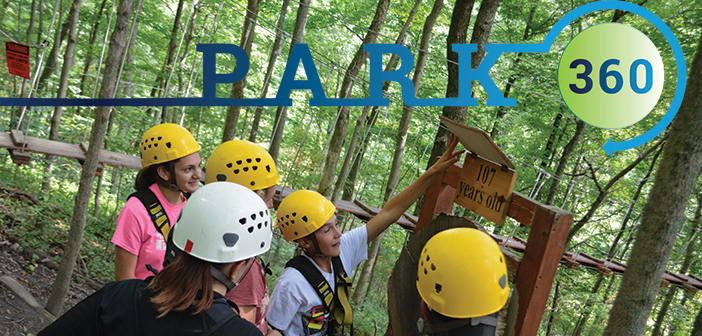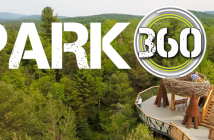Ralph Waldo Emerson, the great 19th-century philosopher, once wrote: “When nature has work to be done, she creates a genius to do it.” In a world where urban and suburban dwellers are becoming less connected to the outdoor environment, adventure parks and zip tours provide a smart way for people to play and reconnect with the natural world. Put another way, in the typical setting of a typical adventure course, there is a lot to be learned from nature.
But how many adventure parks are really taking advantage of the opportunity? To augment an aerial adventure course or canopy tour with an educational component might strike some park operators as a bridge too far. Perhaps they envision logistical hurdles, in particular the cost of educational signage or the need for additional staff training. Perhaps they worry that an educational component, especially if delivered with a heavy hand, might encroach on a park’s main objective: simply to have fun. Or perhaps park operators don’t believe they have the expertise to make fun and education work together seamlessly. Why bother?
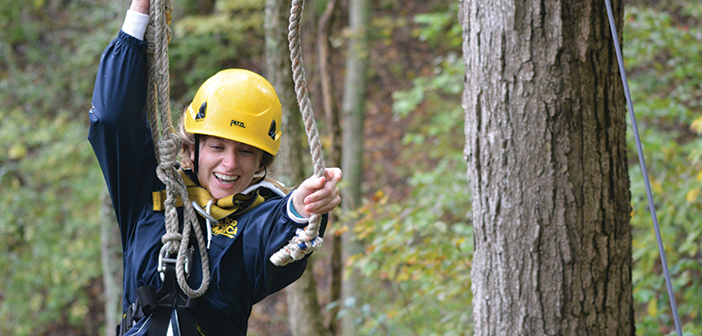
Camp Kern installed a canopy tour in 2009 as a way of addressing “a decline in traditional environmental education” at regional schools.
The answer, says Brian Funtleyder, co-owner (along with wife, Lorrie) of Boundless Adventures, a park building and management company: “The benefits [of an environmental education component]far outweigh the costs.” Boundless Adventures has been working with the Pringle Nature Center in Bristol, Wis., to develop a network of aerial adventure courses to supplement educational activities already in place at the center. The adventure park will open this spring.
ADDING ADVENTURE TO EDUCATION
The adventure park at Pringle, a nine-course installation with varying degrees of difficulty, has many of the common elements that put the fun and adventure into an adventure park, including zip lines. But it is also being designed to conform with the center’s mission statement as a place “where people of all ages can experience nature, environmental education, conservation, and stewardship.” So, this is a case not of an adventure park adopting an environmental education program, but of an environmental education program adopting an adventure park.
Regardless, the two concepts are well matched. Says Barry Thomas, chairman of the board of the Pringle Nature Center, an aerial tour provides a unique chance to teach about “the aesthetic values, recreational values, and commercial values of the forest.”
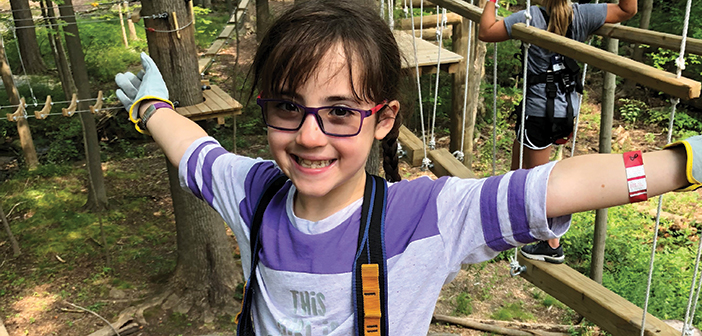
Adventure parks and zip tours provide a smart way for people to play and reconnect with the natural world. Photo credit: Boundless Adventures.
Thomas concedes, however, that in teaching “the importance of forests and forest ecology, standards are fairly broad.” For guidance in honing the focus of its environmental education programs, Pringle maintains contact with regional schools to dovetail with curricular bullet points. In addition, the center has a full-time naturalist on staff.
But curricular bullet points can vary considerably, depending on the age of the participants and the objectives of a particular school group or group leader. The focus of one group might be wildlife, of another the identification of tree species, of another wetland dynamics. Another group might want an omnibus approach and seek to cover all things natural. In all of its educational programs, Pringle seeks to highlight its unique natural features, especially the remnants of an oak savannah, a threatened ecosystem, according to Thomas.
ENVIRONMENTAL ED FOR ALL
Pringle is not alone. Camp Kern, a YMCA-run operation in Oregonia, Ohio, installed a canopy tour in 2009 as a way of addressing a “decline in traditional environmental education” at regional schools, according to Andrew Wright, director of Ozone Zipline Adventures at Camp Kern. The zip-line adventure seemed like a great way to get kids interested in environmental education by making it, simply put, fun. It was an opportunity, as Pringle’s Thomas puts it, for kids “to learn without knowing they’re learning.”
Wright agrees, not just for kids, but also for all park visitors. “People say: ‘We expected to be zip lining, but we learned a lot more.’” Wright also agrees with Thomas that “environmental education” can touch a lot of bases, such as local ecology, geological history, fossils, and physics, among other things. Even engineering details such as the load-bearing capacities of the zip lines can be woven in as teaching moments. Using a little imagination in structuring an educational program can contribute to a better overall learning experience.
Both Pringle and Camp Kern are not-for-profit operations with environmental education as their principle objective. That obviously differentiates them from for-profit aerial adventure parks. So the question is: Why would a for-profit operation want to go through the extra process of organizing and implementing an educational component to augment its activities?
Funtleyder of Boundless Adventures answers the question simply: “Any time you add an amenity that’s attractive, it’s good for business.” That is especially true if, as Funtleyder suggests, the amenity isn’t particularly expensive in terms of infrastructure modification or extra staffing or training. Think of it as an example of the sunroof theorem: If just a couple of extra bucks gets you a sunroof for your new car, why not get the sunroof?
Not including an environmental education component is an opportunity lost, says Funtleyder. “Some parks have completely ignored the fact that they’re in the woods,” he says. In other words, if you have an obvious asset at your disposal, make the most of it. Boundless Adventures operates two other parks, in New York and Massachusetts, and Funtleyder says they try to incorporate environmental education at each.
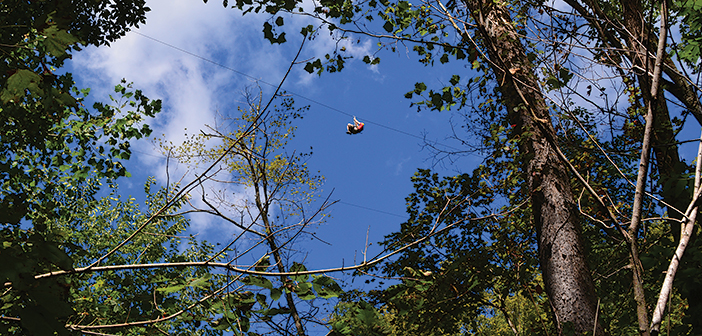
“People say: ‘We expected to be zip lining, but we learned a lot more,’” says Ozone’s Andrew Wright.
For the most part, the implementation of an environmental education component is basically two-fold: signage and staff training. Signs to highlight natural features—e.g., tree species, wildlife corridors, evidence of glacial movements—are relatively inexpensive. And both Thomas and Wright insist that staff training is not much of an extra encumbrance.
Boundless Adventures will manage the Pringle adventure park with its own staff. Because the tours have been designed to be self-guided, with no belaying or spotting necessary, adding environmental education to the park guides’ job description doesn’t necessarily overburden the guides with responsibilities. “The staff is just trained in a different aspect,” says Funtleyder. Given that Pringle specializes in environmental education with the input of a staff naturalist, training is mainly a matter of cross training with other Pringle staff members.
Wright says that at Camp Kern, there isn’t an insistence that guides adhere to a strict curriculum. Staff members are often college students “with an environmental focus. It is part of their outdoor education program,” he says. At its park in New York, Boundless Adventures also taps the environmental interests of students at nearby State University of New York at Purchase.
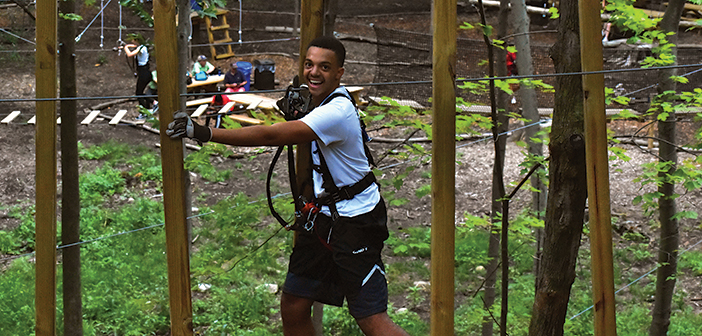
Why add an educational component? “Any time you add an amenity that’s attractive, it’s good for business.” — Brian Funtleyder.
Staff training, says Wright, “provides a foundation, and then [the guides]put their own spin on it.” That fits in well with an effort at Camp Kern to revise and modify some aspects of its educational program on a regular basis. Because the camp hosts a number of returning groups, “We don’t want to deliver the same thing over and over again,” says Wright.
Kids, or groups of kids, are clearly the principal market to which environmental education programs are targeted. But Funtleyder insists that an educational component can appeal to general-admission guests as well. And Wright says that having an environmental education component gives Camp Kern a competitive edge, especially as the number of adventure parks in the region has grown in the decade since the camp first opened its park. “We are an educational canopy tour. That sets us apart a bit,” says Wright.
That said, the exact impact of an environmental education program on a park’s bottom line is difficult to quantify. The assumption is that value is added, but neither Pringle nor Camp Kern could put a precise number on that
value. However, it is probably fair to infer that an educational program,
especially when coordinated with regional schools and their curricula, can have a significant impact on a park’s school-group business.
There is no record to suggest that Emerson ever tried a canopy tour or zip line. But there is little doubt that he would have appreciated, from the unique vantage point that aerial tours provide, all the things that the genius of nature could teach him.


